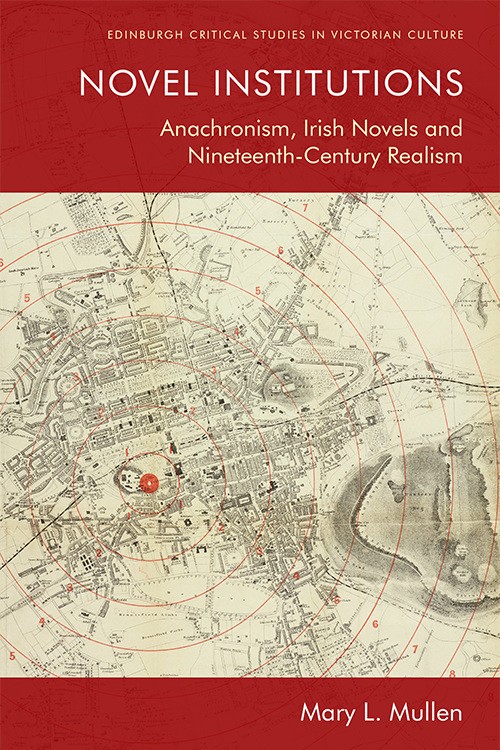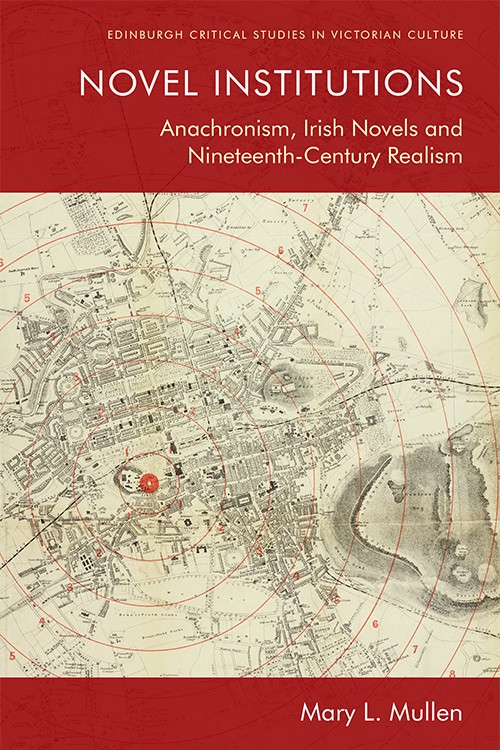
By Mary Mullen
Why wasn’t there an Irish Middlemarch? This is a question that haunts studies of nineteenth-century Irish novels. It positions George Eliot’s Middlemarch as a standard through which to measure the nineteenth-century Irish novel’s failure. A realist classic, Middlemarch’s famous web-like form seems to encourage consensus, integration, and homogeneous time. By contrast, Irish novels of the period seem to produce contradiction instead of consensus, discordance instead of integration, and anachronisms instead of homogeneous time.
Novel Institutions: Anachronism, Irish Novels and Nineteenth-Century Realism considers what we learn when instead of reading Irish novels in relation to Middlemarch, we read Middlemarch in relation to Irish novels. Focusing on novels by Irish writers like Maria Edgeworth, William Carleton, Charles Kickham, and George Moore alongside novels by English writers like George Eliot and Charles Dickens, Novel Institutions argues that nineteenth-century Irish novels teach us three surprising lessons about the literary form we call realism.
1) Realism does not produce shared time. Following the important work of Elizabeth Deeds Ermarth and Benedict Anderson, scholars often claim that realist novels create consensus and help readers imagine the nation by representing characters traveling through time together. But the prevalent anachronisms in Irish novels—out-of-date characters, obsolete practices, and chronological mistakes—show how unruly temporalities persist even in narratives that attempt to foster uniform time. Although realist narratives attempt to bring the multiple historical temporalities within the present onto a shared and singular path, anachronisms persist.
2) Representing the world as it is, realism shows how the world could be otherwise. Realist novels represent everyday life through thick description, references to the real world and a focus on the ordinary rather than the extraordinary. For this reason, realism sometimes seems to stabilize the status quo and establish existing institutions as the horizon for future imagining. But describing existing social arrangements also draws attention to the limits of these social arrangements. Charles Kickham’s Knocknagow: or the Homes of Tipperary, for instance, retreats into the past to show how Irish people remember what the British state forgets. This novel produces a future-oriented nostalgia where political possibilities are located in the seemingly ‘dead past’. Thus, even as realist novels depict everyday life governed by institutions, they also inspire what Roderick Ferguson calls ‘visions that are in the institution but not of it’.[1]
3) Realist conventions are most visible in novels from the colonial periphery. Scholars often see Irish novels as anomalous precisely because they are untimely. Unable to merge plot and politics or to create stable resolutions, they appear to be failures of form. But when these novels seem to fail, they make visible the contradictions that are present but more implicit in mainstream English novels. Irish novels actually demonstrate how British realism is a contradictory dynamic rather than a stable form, showing how even Middlemarch creates discordance rather than integration.
[1] Roderick Ferguson, The Reorder of Things: The University and Its Pedagogies of Minority of Difference, (Minneapolis: University of Minnesota Press, 2012), 18.

Novel Institutions: Anachronism, Irish Novels and Nineteenth-Century Realism publishes in August 2019.

Mary L. Mullen is an assistant professor and member of the Irish Studies faculty at Villanova University. She is the author of Novel Institutions: Anachronism, Irish Novels and Nineteenth-Century Realism.





